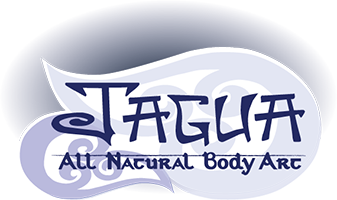What is Jagua?
Jagua (Genipa Americana) is a fruit, a berry to be exact, that grows naturally and widespread thoughout the rainforests of South America. Jagua is edible and used as food coloring by companies in many countries including the United States. We can also apply jagua to the skin, it will leave a stain on the top few layers of skin, creating an all-natural temporary blue/black tattoo.
Jagua Culture & History
Jagua has been used for over 2000 years by native indigenous tribes throughout South America and Panama, as a form of temporary all-natural body art. The jagua fruit also has a natural medicinal quality, in which it deters stinging insects and acts as an all-natural bug repellent. Jagua is also edible, and has been known to be used as all natural food dye in candy produced in the United States.
Many indigenous tribes in South America use jagua body art as apart of ceremony and celebrations. The Kayapo, a native indigineous tribe of central Brazil, also known as the Mebengokre or “the men from the water place“, were featured in National Geographic article 'Kayapo Courage' by Chip Brown. The printed article is accompanied by beautiful portraits of the people and the cheifs. All of them adorned with dark blue tattoos on their face and body. According to the article, the body paint was created with a mixture made of fruits, nuts and charcoal. In the short video documentary "The Land of Jagua", the narrator tells us how traditionally amongst the Matsés people, the jagua is mixed with soot and then applied to the skin. By creating a market for jagua body art in the United States, we are in turn supporting the people native to South America with and their unique heritage and cultural traditions.
Reference: Brown, Chip. "Kayapo Courage" National Geographic Magazine, January 2014, 31-54.
Reference: Giacomini, Pascal. "The Land of Jagua" A Documentary Film by Pascal Giacomini, 2009.
How is Jagua produced for body art? Who makes it?
To turn the jagua fruit into a gel suitable for body art, it goes through a process. Each jagua supplier has their own way of extracting the gel, either boiling the fruit down or squeezing the juice from the berry before adding other natural ingredients to make it a nice gel-like quality. Other all-natural ingredients include citric acid, lavender essenial oil and xanthum gum.
Fresh all natural jagua can be purchased from trusted and experienced suppliers in the United States. Reputable jagua suppliers can be found in many of the new Jagua discussion groups your can find on facebook, featured on the Jagua Resources page. Many suppliers work with local indigienous tribes, manufacture and produce the jagua fruit sustainably. By creating a market for all natural jagua body art you are supporting native people specifically in the Darien Gap, Panama, the Kayapo in Brazil and the Matsés people in Peru. Production of the jagua berry for use as food dye and as a temporary form of body art creates a sustainable agricultural business for the native people of South America and the reforestation of local areas.
Is Jagua Safe? Can I have an allergic reaction?
Jagua is derived from allnatural plant material, and like any allnatural plant or material, it can cause allergic reactions in some people. If you have allergies to other berries like blueberries or strawberries, than you should not try jagua at all. If you have any concerns or senstive skin, it is recommended that you try a small skin test before applying a full tattoo. Put a small dab on your skin. If you do not experience any itching or redness, then you are not allergic to Jagua. You can purchase small amounts of fresh allnatural jagua from suppliers in US.
I have specifically offered jagua body art professionally in the San Francisco Bay Area and at festivals throughout California, Oregon and Washington since 2009. I have done jagua on hundreds of people, including 1 pregnant mother who had received jagua body art one other time before she was pregnant. I also have clients who have been booking jagua appointments with me for 4+ years.
In all of my years of experience using jagua for body art, only one time did a client experience an allergic reaction to jagua. That particular client had the jagua done on his shoulder / upper arm as well as his calf / lower leg. Only his upper arm had a reaction which resulted in a red rash that cleared up after 1 day.
What will happen if I have a bad reaction to jagua? Generally, the reaction will not be severe. You will experience itchiness and redness of the skin. It can last 1 to 7 days. Use hydrocortison or other all-natural remedy to aid in relieving the itchiness. If you are having an experience that is more severe than this, you are either highly allergic to jagua, or perhaps the artist you received the "jagua" from, was not using jagua at all and they were using harsh chemicals or mixed it with other unsafe chemicals into their jagua mix.
I would recommend that you are fully aware of and educated about any substance that you put into or on your body, so that you can make the best decidsion for yourself. Whether it is the food you are eating, the laundry detergent you are using or the substance you are allowing another person to permanently or temporarily tattoo your body with. Please always be informed about what you are putting onto and into your body. If you find an artist selling jagua or henna tattoos, always ask them if it is fresh and all-natural! If they cannot tell you what is in their jagua gel or henna paste, chances are it could be PPD, black henna or who knows what!?! Learn about the similarities and differences of all natural jagua and henna, and the dangers of black henna.
